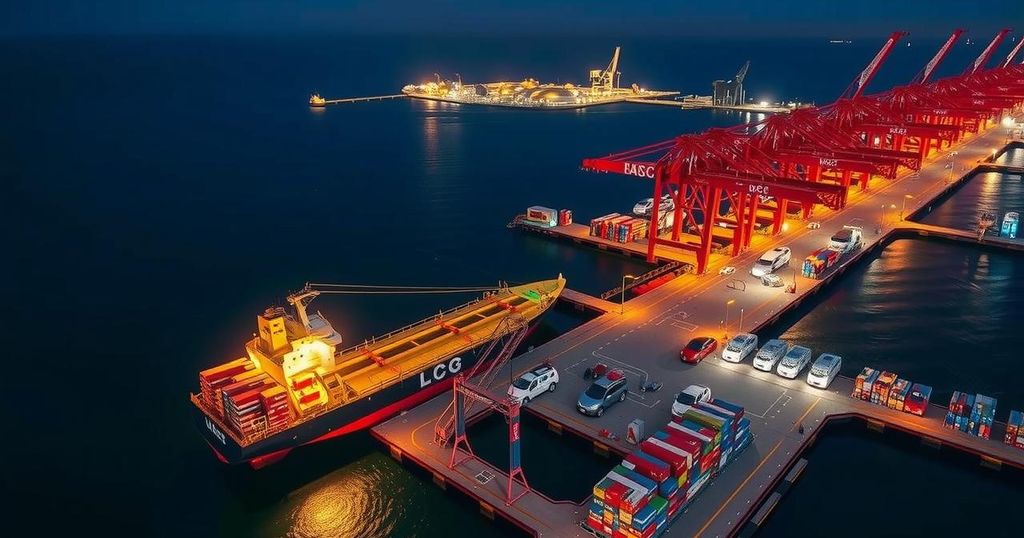A recent seizure of 43 metric tons of sodium carbonate at Arica port in Chile highlights its emerging significance in Bolivian drug trafficking. The precursor, falsely labeled, was bound for Bolivia and represents one of Chile’s largest drug seizures. Arica’s customs framework aids trafficking activities, and with increased cocaine production in Bolivia, the port is set to remain a central hub for drug operations.
The recent large-scale cocaine precursor seizure at Arica port in Chile highlights the increasing significance of this location in the Bolivian drug trafficking chain. On November 5, authorities reported the confiscation of 43 metric tons of sodium carbonate, a compound that can be utilized in cocaine production, which originated in Hong Kong and was destined for Bolivia. Falsely labeled as “tile adhesive,” the seized materials were linked to a Bolivian transport firm, which is now facing scrutiny from officials. Mario Carrera, an Arica-based prosecutor, noted that this seizure is one of the most substantial in Chile’s history, emphasizing the potential economic implications of the drugs that could have been synthesized from the precursor. Sodium carbonate, inherently a legitimate substance used in industries such as glass manufacturing, is also employed in the cocaine extraction process from coca leaves. Arica’s strategic location near Bolivia, coupled with its unique customs processes, designates it as a crucial junction for both precursor importation and cocaine exportation. A treaty from 1904, dated to the period following the war between Chile and Bolivia, still plays a role today by allowing Bolivian customs officials considerable oversight over cargoes moving through Arica, which limits Chilean inspections. Recent years have seen Arica port as the scene of several noteworthy drug-related seizures. Prior incidents include the interception of 8.7 tons of cocaine in December 2023 and the discovery of 2.2 tons heading for Belgium in July 2023. Comparatively, despite Peru being closer geographically, its extensive coastline diminishes Arica’s relevance for Peruvian cocaine traffickers. Approximately 75% of Arica’s cargo is linked to Bolivia, evidencing a significant growth of Bolivian trafficking operations through the port, with a 30% increase noted in Bolivian cargo traffic from 2022 to 2023. Authorities have pointed out the advantageous conditions for drug traffickers utilizing Arica, notably due to limitations on customs inspections by Chilean officials on Bolivian cargo. Furthermore, Luis Carrera commented on Chile’s comparatively low levels of corruption, which earn Arica a more favorable standing among traffickers. The introduction of new policies that lower tariffs on Bolivian goods passing through Arica’s port, along with the escalation of cocaine production in Bolivia, is likely to contribute to an upsurge in drug trafficking via this terminal in the foreseeable future.
The issue of drug trafficking, specifically from Bolivia through Arica port in Chile, is contextualized within historical trade agreements that afford Bolivia certain operational advantages. Bolivia’s landlocked status necessitates the transit of goods through neighboring countries like Chile, and past treaties have influenced contemporary customs practices. Recent seizures at Arica port illustrate the ongoing challenges faced by authorities as they combat organized crime and drug trafficking, significantly affecting regional security and public health agendas in South America.
In conclusion, the substantial seizure of sodium carbonate at Arica port exemplifies the critical role this location plays in Bolivia’s drug trafficking networks. The combination of strategic geographical advantages, historical customs regulations, and low levels of corruption contributes to Arica becoming an increasingly preferred conduit for drug traffickers. As drug production in Bolivia continues to rise, coupled with favorable tariff agreements, vigilance and enhanced law enforcement measures will remain essential to counteracting these illicit operations effectively.
Original Source: insightcrime.org






